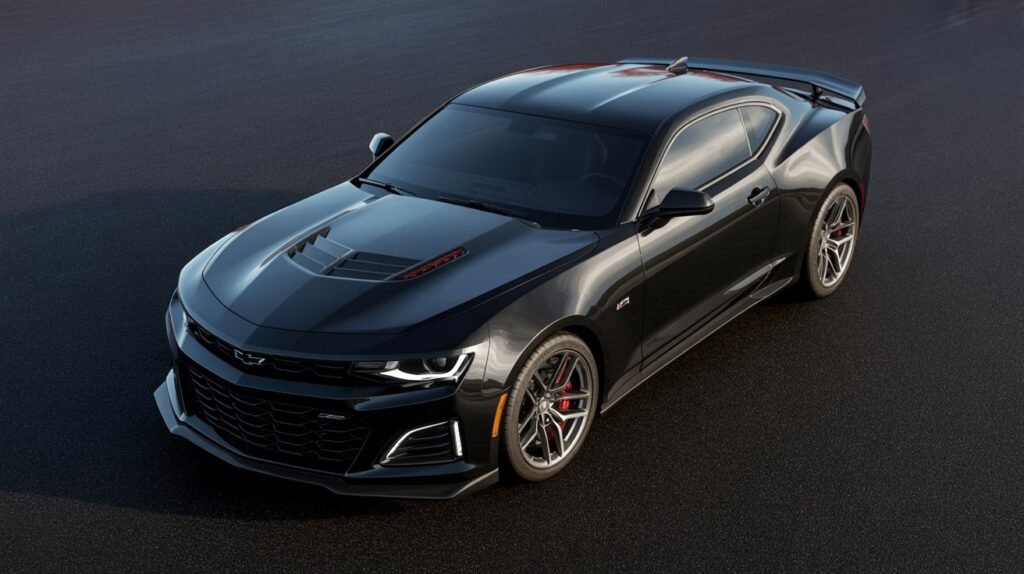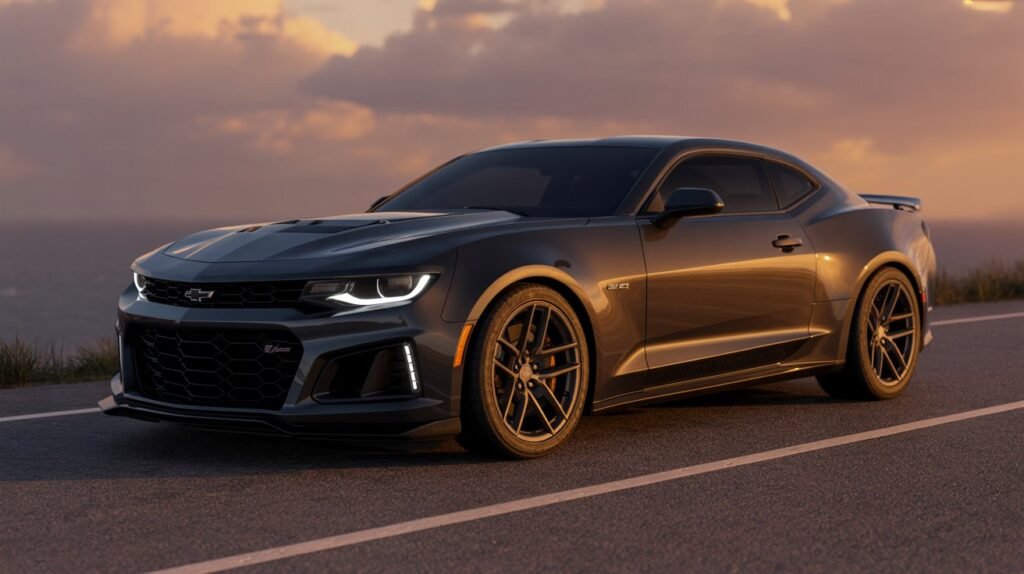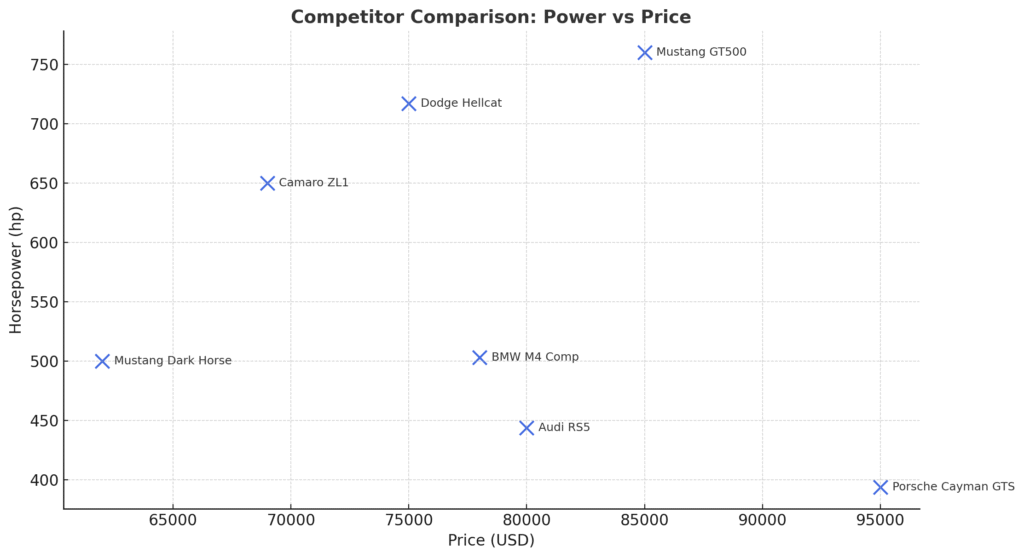Introduction
The Chevrolet Camaro ZL1 has long stood as the wild side of Chevy’s muscle car lineup. It is a machine built to thrill on the drag strip yet composed enough for a cross-country cruise. In 2025, it carries the weight of heritage while facing an evolving market where turbocharged European coupes and electric muscle cars are quickly reshaping expectations.
This isn’t just another trim level. The ZL1 is the Camaro at full volume. With its supercharged V8, track-ready chassis, and aggressive aero package, it represents the peak of American muscle performance. But the question is simple: does it still hold its crown in 2025, or is the competition closing in?
In this review, we’ll break down what’s new for 2025, explore its design, tech, and performance, and compare it against rivals like the Mustang Shelby GT500 and Dodge Challenger SRT Hellcat. By the end, you’ll know whether the Camaro ZL1 is still the ultimate muscle car to buy, or if your money should go elsewhere.
Table of Contents
What’s New for 2025
Chevrolet hasn’t reinvented the Camaro ZL1 for 2025, but it has refined the formula in ways that matter to enthusiasts. The updates focus on design tweaks, small performance improvements, and technology enhancements that keep the car relevant in a fast-changing market.
Design and trim updates
The 2025 ZL1 gets a sharper front fascia with more pronounced aero elements, giving it an even more aggressive stance. New wheel designs and fresh color options, including a striking metallic blue, offer more personalization for buyers. Subtle revisions to the rear spoiler and diffuser improve high-speed stability while preserving the muscular Camaro look.
Mechanical and tech upgrades
The ZL1 continues with its supercharged V8, but Chevrolet has optimized cooling and software tuning to improve throttle response. Drivers also benefit from an upgraded performance traction management system, making it easier to harness the car’s power on both street and track. On the tech side, the infotainment system now runs on a faster processor with improved graphics, while wireless smartphone integration is standard.
Why it matters
For a performance car at this level, incremental changes make a big difference. The styling updates keep the Camaro ZL1 visually competitive against fresher rivals, and the tech refinements improve daily usability. Combined with sharper handling adjustments, the 2025 model ensures that the ZL1 remains more than just a legacy muscle car it is still a serious contender in modern performance culture.
Exterior Design and Styling

The 2025 Chevrolet Camaro ZL1 looks every bit as aggressive as it performs. Chevrolet has sharpened the bodywork with a front fascia that pushes more air into the cooling system while carving out a menacing presence on the road. The wide grille, flanked by slimmer LED headlights, emphasizes width and gives the car a planted stance.
Functional aero defines the ZL1’s look. The sculpted hood with its prominent heat extractor channels hot air away from the supercharged V8, while the lower splitter and side skirts reduce lift at high speeds. At the rear, buyers can opt for a tall track-inspired wing or a subtler lip spoiler, each tuned to improve stability.
Chevrolet has also introduced new wheel designs for 2025, including lightweight forged alloys that highlight the massive Brembo brakes behind them. Fresh paint choices, like Metallic Blue Ice and a deep Satin Red Tint, add to the customization options without straying from the Camaro’s bold personality.
The result is a car that balances form and function. Every crease and vent serves a purpose, yet the overall design still appeals to muscle car purists who want their car to look as fast as it drives. It is unapologetically aggressive, and that is exactly the point.
Interior, Comfort, and Tech
Step inside the 2025 Camaro ZL1 and the first impression is clear: this is a cockpit built for drivers. The low seating position, thick flat-bottom steering wheel, and heavily bolstered Recaro seats immediately signal performance intent. At the same time, Chevrolet has refined the materials for 2025, adding soft-touch surfaces on the dash and new stitching patterns that give the cabin a more premium feel.
The ZL1 doesn’t try to be a luxury cruiser, but it avoids the stripped-down track-car vibe. Dual-zone climate control, heated and ventilated front seats, and an optional suede package make long drives less punishing. Visibility remains a weak point due to the Camaro’s high beltline and narrow windows, yet once you settle into the driving position, the cabin feels focused and immersive.
Technology sees meaningful upgrades this year. The updated 10.2-inch infotainment screen is quicker to respond, and the graphics have been sharpened. Wireless Apple CarPlay and Android Auto are now standard, along with a Wi-Fi hotspot and over-the-air update capability. Audiophiles can opt for a premium Bose sound system, which brings surprising clarity even when the V8 is roaring.
Practicality is where the ZL1 shows its compromises. The rear seats are cramped to the point of being symbolic, and the trunk opening is small. However, for most buyers, these shortcomings are secondary to the car’s purpose. Safety tech has also caught up, with features like forward collision alert, blind-spot monitoring, and a head-up display included to make daily driving less stressful.
Powertrain and Performance
At the heart of the 2025 Camaro ZL1 lies a supercharged 6.2-liter V8 that defines the car’s character. With well over 650 horsepower on tap, it delivers explosive acceleration and a sound that feels unmistakably American. Buyers can choose between a six-speed manual transmission for a raw, mechanical connection or a lightning-quick 10-speed automatic that maximizes performance on track and in straight-line runs.
Power delivery and drivetrain
The engine’s supercharger provides instant low-end torque and relentless pull through the rev range. Power is sent exclusively to the rear wheels, reinforcing the ZL1’s muscle car identity. An electronically controlled limited-slip differential helps manage traction, and multiple drive modes let the car shift from docile city driving to aggressive track readiness with a single selection.
Chassis, suspension, and braking
Chevrolet equips the ZL1 with Magnetic Ride Control dampers that constantly adapt to road conditions, providing surprising compliance on rough pavement and razor-sharp body control in corners. A performance traction management system fine-tunes throttle and stability control to suit track conditions, while massive Brembo brakes deliver consistent stopping power. Optional carbon-ceramic rotors reduce fade during extended lapping sessions.
On-paper versus real-world performance
On paper, the ZL1’s acceleration figures are staggering, with 0 to 60 mph times comfortably in the three-second range. Top speed pushes beyond 190 mph, placing it in supercar territory. In the real world, what stands out is the way the car manages its power. Instead of being a blunt instrument, the ZL1 feels composed when driven hard, making it more approachable for skilled enthusiasts who want track pace without constant fear of losing control.
The combination of raw power, advanced chassis tuning, and track-tested hardware makes the Camaro ZL1 one of the most complete muscle cars available today.
Ride, Handling, and Driving Impressions
The Camaro ZL1 doesn’t just rely on raw horsepower. Its ability to blend everyday drivability with track-ready sharpness is what sets it apart from lesser muscle cars.
On the street, the ZL1 surprises with a level of refinement most wouldn’t expect from a 650-horsepower machine. Magnetic Ride Control softens impacts over rough pavement, making the car livable even in city traffic. Steering is quick and precise, with enough feedback to remind you this is a serious performance car but without being overly twitchy. Road noise is present, yet the cabin feels solid, and the exhaust note can be quieted through drive modes when discretion is needed.

Take the ZL1 to a track, and the character shifts dramatically. The chassis tightens, the brakes bite harder, and the supercharged V8 unleashes its full fury. Cornering grip is immense thanks to wide performance tires and a well-balanced suspension setup. Stability is excellent even at high speeds, and the car feels more composed than raw muscle cars of the past. Heat management, a common weakness in high-performance cars, is improved by upgraded cooling systems, allowing the ZL1 to handle multiple hard laps without fading.
The trade-off is clear: this is still a firm, focused performance car, not a luxury grand tourer. Long road trips will reveal its stiffer ride and limited practicality. But for drivers who want a car that feels equally thrilling on a Sunday morning canyon run as it does on a proper racetrack, the ZL1 delivers one of the most balanced experiences in its class.
Fuel Economy, Ownership, and Running Costs
Nobody buys a Camaro ZL1 expecting Prius-like efficiency, but it is still important to know what living with one entails. The supercharged V8 consumes fuel at a rapid pace, with EPA estimates typically landing in the mid-teens for city driving and low twenties on the highway. Aggressive driving or track use can push those numbers even lower, and premium fuel is mandatory.
Tires are another major expense. The ZL1 comes fitted with ultra-high-performance rubber that offers incredible grip but wears quickly under hard use. Owners who track their cars regularly may find themselves replacing a set of tires every season. Brembo brakes provide excellent stopping power, but replacement pads and rotors also come at a premium.
Insurance costs tend to run higher than average, given the car’s performance credentials and repair costs. Routine maintenance, however, is relatively straightforward. The V8 is a proven engine, and Chevrolet’s service network makes ownership easier compared to niche European sports cars. Scheduled maintenance is comparable to other high-performance vehicles in this price bracket.
Depreciation is another factor. While muscle cars traditionally lose value faster than some European rivals, special models like the ZL1 often hold their appeal among enthusiasts, especially if kept in good condition and with low mileage. Collectors and track-day drivers continue to see it as a desirable machine, which helps soften long-term value loss.
In short, owning a 2025 Camaro ZL1 is not cheap, but it is also not out of line for a high-performance car with this level of power and capability. Buyers should budget realistically for fuel, tires, and insurance, while enjoying the fact that the car delivers thrills that justify the running costs.
Trim Levels, Packages, and Options
The 2025 Chevrolet Camaro ZL1 is offered in a single high-performance trim, but Chevrolet provides flexibility through body styles, packages, and add-ons.
- Camaro ZL1 Coupe – Starting at $72,100
The standard ZL1 coupe comes equipped with the 6.2L supercharged LT4 V8, a 6-speed manual transmission (with optional 10-speed automatic), Brembo brakes, Magnetic Ride Control, Recaro sport seats, and a 12.3-inch digital driver cluster. - Camaro ZL1 Convertible – Starting at $78,100
The convertible version carries the same powertrain and features as the coupe but with a retractable soft-top. The added open-air experience raises the price slightly.
Performance Packages and Options
- 1LE Extreme Track Package (Approx. +$7,500)
- Carbon-fiber rear wing
- Multimatic DSSV dampers
- Track-focused suspension calibration
- Goodyear Eagle F1 SuperCar R3 tires
- Weight reduction upgrades
- Transmission Options
- Standard: 6-speed manual with rev-matching
- Optional: 10-speed automatic with paddle shifters (+$1,595)
- Cosmetic/Interior Options
- Carbon-fiber trim upgrades
- Premium infotainment with navigation
- Performance data recorder
- Upgraded Bose audio system
With options, a fully loaded ZL1 can exceed $85,000, especially when the 1LE package and interior upgrades are added.
Competitor Comparison
The Camaro ZL1 sits in a unique spot in today’s shrinking muscle car landscape. While the traditional pony car wars are winding down, Chevrolet has ensured that the ZL1 remains competitive against both domestic and international rivals.

Dodge Challenger SRT Hellcat
- Power: 717 hp from a supercharged 6.2L HEMI V8
- Price: Starts around $75,000
- Strengths: Brutal straight-line speed, aggressive styling, wide-body options
- Weaknesses: Heavier than the ZL1, less nimble in corners, aging interior design
The Hellcat delivers raw horsepower and drag-strip performance, but the ZL1 provides sharper handling and a more balanced driving experience.
Ford Mustang Dark Horse / Shelby GT500
- Dark Horse Power: 500 hp from a 5.0L V8 (starting around $62,000)
- Shelby GT500 Power: 760 hp from a 5.2L supercharged V8 (around $85,000)
- Strengths: Track credibility, modern tech, wide aftermarket support
- Weaknesses: The Dark Horse falls short in power compared to the ZL1, while the GT500 is priced higher and discontinued after 2022
Chevrolet positions the ZL1 between these two Ford options, offering more power than the Dark Horse while undercutting the GT500 in price.
European Alternatives (BMW M4 Competition, Audi RS5, Porsche Cayman GTS)
- Price Range: $78,000 – $95,000
- Strengths: Luxury interiors, cutting-edge technology, European prestige
- Weaknesses: Higher cost, less dramatic power delivery, pricier maintenance
The Camaro ZL1 may lack the refinement of a BMW or Porsche, but it delivers supercar-level acceleration and track ability for significantly less money.
Verdict: Against its American rivals, the ZL1 balances muscle with agility. Against European sports coupes, it punches above its weight in performance per dollar.
Pros and Cons
Pros
- Supercharged V8 performance – The 650-hp LT4 delivers blistering acceleration with an intoxicating exhaust note.
- Balanced handling – Magnetic Ride Control, electronic limited-slip differential, and available 1LE package make the ZL1 track-capable straight from the factory.
- Value for money – Starting around $72,100, it offers supercar-level performance at a fraction of the cost.
- Aggressive styling – Aerodynamic design with functional vents and a wide stance that looks as fast as it drives.
- Customization options – Coupe or convertible body styles, manual or automatic transmission, and multiple packages to suit different driving styles.
Cons
- Limited practicality – Rear seats are cramped and trunk space is small, making it less versatile as a daily driver.
- Visibility issues – The low roofline and thick pillars can make outward visibility challenging.
- Fuel economy – At 14–20 mpg, it’s thirsty compared to more modern hybrid and EV sports cars.
- End of an era – With Camaro production winding down, long-term availability and support are uncertain.
- Interior refinement – Functional but less premium compared to European competitors in the same price range.
Conclusion & Final Takeaways
The 2025 Chevrolet Camaro ZL1 stands as one of the last true American muscle cars, blending brute force with track-ready engineering. Its 650-horsepower supercharged V8, sharp handling, and aggressive design make it more than just a straight-line rocket. It’s a car that can thrill on the drag strip and hold its own on a road course, all while undercutting many European rivals on price.
Yes, it has drawbacks: fuel economy is poor, visibility is challenging, and its practicality is limited. Yet for enthusiasts who value performance above all else, these compromises are part of the charm. With production nearing its end, the ZL1 is not just a performance bargain but also a future collectible that represents the closing chapter of the Camaro legacy.
For buyers seeking a raw, visceral driving experience before the automotive world shifts fully toward electrification, the Camaro ZL1 is one of the best options still available. It’s loud, it’s unapologetic, and it’s everything a muscle car should be.
Pingback: Maserati MC20 2025 Review: Performance, Design, Price, and Competitors -
Pingback: 2025 Chevrolet Corvette E-Ray: Hybrid Supercar Review -
Pingback: 2026 Dodge Charger Sixpack: Power, Specs & First Look -